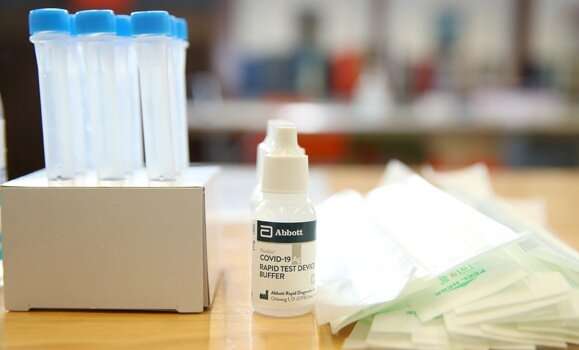Research informs new recommendations to swab nose and throat on COVID rapid tests

Over the past two years, many Nova Scotians have become intimately familiar with COVID-19 rapid testing. Whether at a pop-up clinic or at home, the practice of sticking the swab up your nose and getting a quick positive or negative result has become a key part of our collective pandemic response.
The way you conduct those rapid tests is about to change, though, thanks to evidence collected by Dalhousie and Nova Scotia Health experts.
Until now, the technique for carrying out a rapid test has been to swab the inside of your nose for a sample. New recommendations from Nova Scotia Public Health released Friday now suggest that adding a simultaneous throat swab during the process produces significantly more accurate results in detecting the currently dominant Omicron variant.
The shift in guidance is based on the results of research led by Dr. Todd Hatchette, head of Nova Scotia Health's microbiology team and a professor in Dal's Department of Pathology and Laboratory Medicine.
Dr. Hachette and his team are the first to report research results that support a combined throat/nose sample collection method for self-administered rapid tests. Based on 1,500 samples collected by volunteers at community rapid-testing sites in Nova Scotia, the research showed that compared to PCR test results, samples from nasal or throat swabs on their own detected 64.5 percent of cases. However, combining the nose and throat swabs increased sensitivity to 88.7 percent.
"These types of projects are instrumental in testing anecdotal reports of new collection methods that are different from the manufacturers' approved collection recommendations. Projects like this are critical in our response to COVID-19," said Dr. Hatchette in a release from Public Health.
"This data now supports the option of using a combined throat/nasal swab to enhance detection of omicron. It can be used to inform community practice and increase confidence for those making swabbing recommendations to various stakeholders and users."
Testing instructions to change
Public Health says it plans to update the testing instructions it hands out to people when they pick up tests. (Current manufacturer instructions that come with the tests recommend a nose swab only.) The health authority also suggests that if you wish to choose only one location for a sample, the nasal swab is more effective than a throat swab alone.
The research has been submitted for publication. Dr. Hachette is joined by project co-authors Barbara Goodall and Drs. Jason LeBlanc, Lisa Barrett and Glenn Patriquin.
Rapid testing has been front and center in Nova Scotia's approach to managing COVID-19 since early in the pandemic, with Dr. Hachette, Dr. Barrett and others Dal and Nova Scotia Health colleagues spearheading rapid-testing clinics in communities and other innovative initiatives.
"This is another example of how vital Dalhousie researchers have been to our collective pandemic response," says David Anderson, dean in the Faculty of Medicine.




















